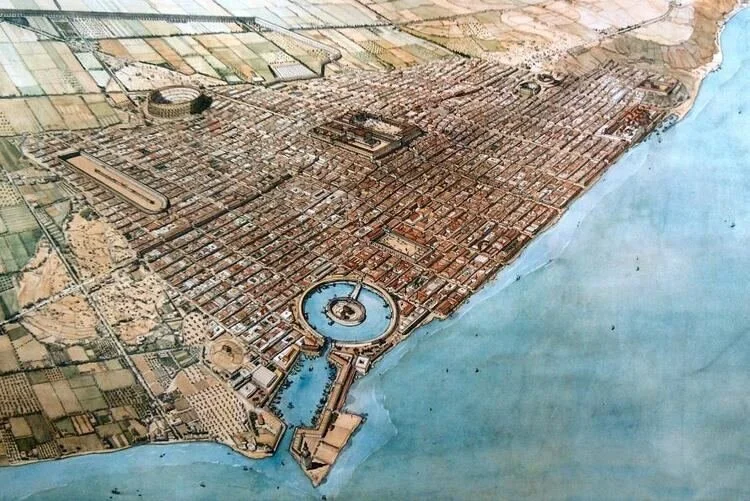Carthage
How on Earth do you summarise the ancient city of Carthage?! On Saturday we spent a full day exploring the archaeological sites of this old world, once the most affluent and powerful city in the Mediterranean. It was truly a once-in-a-lifetime opportunity to visit this UNESCO World Heritage Site, and we had the entire place to ourselves. It’s taken us a while to process it all!
The Punic Republic of Carthage was founded sometime between the fall of Troy and the first Olympiad, secured in its tactical location for maritime trade. It fell to Rome some 600 years later, completely razed to the ground after three wars. So it’s hard to comprehend the vast history that lies in this region of Tunisia.
Today most of what’s left are the new ruins of the Roman Empire, with sweeping views of the Gulf of Tunis. Large fields strewn with wild flowers lay undeveloped around the city, whilst layers of history sit beneath the soil waiting to be uncovered.
Carthage Museum
Although the actual museum was closed for renovation works, we were able to tour the grounds. Once the beating heart of the city, today there are just scant remains left of the citadel of Byrsa. But we imagined the imposing temples, judicial courts, burial quarters and grand villas that used to stand here and govern the ancient world.
Carthage was founded by Dido, Queen Elissa of Tyre (now Lebanon), after she was exiled with a fleet of ships full of royal gold, following the murder of her husband by her own brother. It is said that the entire city of Carthage was encircled by walls 13m high and 10m thick. The Carthaginians were seafarers and traders, and established colonies throughout North Africa, southern Spain, and Italy.
The city’s most famous son, General Hannibal, is often regarded as one of the greatest military tacticians in history. His command against the Romans is legendary, leading elephants over the Alps to defeat the Romans, and it almost lead to their downfall. Yet the fires that eventually consumed Carthage in 146 BCE burned for three weeks straight, and evidence of that fire still remains today; the stone walls of General Hannibal’s quarters are forever changed from a yellowish brown to burnt sienna.
Following the fall and total destruction of Carthage, it was rebuilt by the Romans. Its rise from the ashes began under Julius Caesar and continued under Augustus. By the 1st Century CE it had once again become one of the largest cities in the Mediterranean.
Yet another 600 years on, the city was plundered by the Vandals, ruled by The Byzantine Empire, and destroyed once again by the Arabs. Today it is a modern suburb of the capital Tunis.
Roman Amphitheatre
This 2nd Century amphitheatre was once a five-storey structure that could seat some 50,000 spectators. It was considered one of the largest of the Roman Empire; an imposing oval-shaped structure topped with 54 high arches, and an arena that could be flooded for mock naval battles.
Today its massive foundations and just a few underground rooms remain. There were no other tourists when we visited, so we ran freely through the underground tunnels pretending to be great gladiators from the past. And we imagined the wild animals that would have been brought here to do battle for the crowds, where today just a few wildflowers sit in their place.
Roman Theatre
Another feat of Roman engineering, this imposing construction could hold 10,000 spectators. It was built against the hillside, but not leaning on it - the tiers instead supported by a complex system of vaults, protecting the building from any earth movement. But alas, this large theatre was destroyed long ago by the Vandals. It has since been reconstructed, though somewhat unsympathetically. Today it hosts an international music festival each summer, and other theatre performances throughout the year (COVID notwithstanding). Once again we had the place to ourselves.
Antonine Baths
This mammoth complex was probably the most impressive on our tour of Carthage. Completed some 2,000 years ago and sprawling along the Mediterranean coast, this huge Roman Thermae was the largest outside of Rome and took 15 years to build. Once an opulent three-storey leisure centre, it was filled with heavy marble columns topped with vast cupolas and surrounded by beautiful landscaped gardens.
It housed multiple saunas, indoor & outdoor Olympic-sized swimming pools, hot, warm & cold rooms, gymnasiums, change rooms and lavatories. Everything built twice in symmetrical layout, in order to service men and women separately. Given the proximity of the baths to the ocean (the building apparently included direct access to the sea via a staircase), it’s a wonder anything is left standing at all.
It is here that Emperor Hadrian built one of the longest aqueducts in the Roman Empire, suppling the citizens of Carthage with fresh water from the mountains 132km away, including the Antonine Baths. A feat of supreme engineering in its own right by anyone’s standards.
We wandered through what remains; the basement level service areas (furnaces, storage areas, staff rooms and water supply areas). Yet the sheer size of the ruins makes it easy to imagine the imposing building that once stood here. The grandeur and majesty alluded to by scattered mosaics, broken marble and stones inscribed with Latin.
The Punic Port
The last stop on our tour of the archaeological site of Carthage was the legendary Punic Port, an important point of trade and the basis of Carthage’s power and prosperity. Although the site was closed when we visited, we were still able to clearly see the famed circular naval port. It was strategically hidden behind an oblong merchant port, and had covered moorings for an incredible 220 vessels in dry docks. However the ports were filled in long ago, and rises in the sea level mean that the harbour was no longer useful even by the time the Romans had moved in.
It was a huge day exploring what is essentially a pile of rocks! But what they represent is fascinating. The stories of so many lives lived before ours. Of innovation and possibility from people who have made their mark on the landscape. A warning that life is fleeting and fragile. A reminder that we aren’t the first, and certainly won’t be the last.























